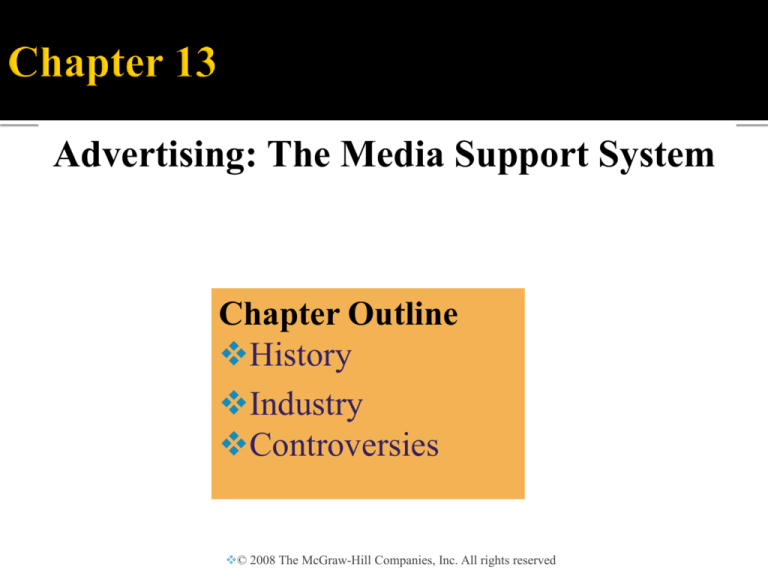
Advertising: The Media Support System
Chapter Outline
History
Industry
Controversies
© 2008 The McGraw-Hill Companies, Inc. All rights reserved
Advertising is an Ancient Activity
Ancient Egyptians had roadside billboards carved in stone.
Gladiatorial shows were advertised on the walls of ancient
Rome.
Ancient Greeks had town criers who shouted advertising in the
streets.
▪ Sometimes accompanied by musicians
▪ Ancient advertisers understood value of entertainment in conveying their
message.
© 2008 The McGraw-Hill Companies, Inc. All rights reserved
Advertising is an Ancient Activity
The first printed advertisements were handbills
▪ Announcements on single sheets of paper
▪ Often posted on the doors of churches.
© 2008 The McGraw-Hill Companies, Inc. All rights reserved
Advertising Comes to America
Many settlers came to America because of advertisements
they read in England touting free and fertile farmland.
American newspaper, the Boston News Letter,
▪ Trade advertising
▪ Notices of wares for sale from manufacturers & local merchants.
▪ Not much use for consumer advertising
▪ Most Americans made their own clothing and grew their own food.
© 2008 The McGraw-Hill Companies, Inc. All rights reserved
Ads and the Industrial Revolution
Advertising led to the diffusion of almost every type of
innovation.
▪ Encouraged people to bathe more often.
▪ Encouraged teeth brushing and clothes washing.
▪ Encouraged men to shave daily rather than visit a barber
every few days.
▪ Autos advertised as the solution to air pollution caused by
dried horse manure blowing through the streets.
© 2008 The McGraw-Hill Companies, Inc. All rights reserved
Early Industry Control
Advertisers were prone to exaggeration, or puffery.
By the late 1800s, advertisers were making outrageous claims
and outright deceptions.
Miracle elixirs promised to cure gout, tuberculosis, and heart
disease but many were flavored drinks that were mostly alcohol
and often contained addictive drugs such as heroin and
morphine.
© 2008 The McGraw-Hill Companies, Inc. All rights reserved
Early Industry Control
The Pure Food and Drug Act was passed in 1906 largely in
reaction to patent medicine claims.
▪ Pure Food and Drugs Act does not prohibit false therapeutic claims only
false and misleading statements about the ingredients or identity of drug.
The Federal Trade Commission (FTC) was established in 1914
as a national watchdog of business and advertising.
© 2008 The McGraw-Hill Companies, Inc. All rights reserved
Ads Take to the Airwaves
As the radio industry developed in the early 20th Century
▪ Movement to leave broadcasting free of advertising and run it as a
common carrier of mediated interpersonal communication.
Britain decided to fund its state-run broadcasting system, the
BBC, by license fees paid by radio owners, not advertising.
▪ British radio and television did not accept advertising until the 1950s.
© 2008 The McGraw-Hill Companies, Inc. All rights reserved
Ads Take to the Airwaves
In 1922, the first commercial was run by AT&T’s WEAF in
New York.
By 1926, when network radio began, advertising had become
an acceptable means of supporting radio.
© 2008 The McGraw-Hill Companies, Inc. All rights reserved
Advertising became a specialized art form with the advent
of television.
▪ TV ads became 30-second entertainments with characters
such as Speedy Alka-seltzer singing catchy jingles like
“Plop, plop, fizz, fizz, oh, what a relief it is!” that people
were humming the next day.
Commercial
© 2008 The McGraw-Hill Companies, Inc. All rights reserved
One failed but controversial attempt at a new style of
promotion involved subliminal advertising,
▪ Advertising that the consumer was not consciously aware of.
Subliminal Message Video
© 2008 The McGraw-Hill Companies, Inc. All rights reserved
Diversity and Target Marketing
Target marketing
Breaks up the ad audience into diverse segments to reach
individuals likely to purchase a particular product.
▪ Advertisers like to minimize circulation waste,
▪ Part of advertising received by people not trying to be reached.
▪ Advertisers direct ad campaigns toward women, African
Americans, Hispanics and others.
© 2008 The McGraw-Hill Companies, Inc. All rights reserved
Advertising begins with clients who provide the product
to be sold.
▪ Clients spend about 20 percent of revenue on advertising.
▪ The gross dollar amount spent is known as billings.
There are over 13,000 ad agencies in the U.S.
In-house agencies
▪ Are built into the client’s corporate structure.
Boutique agencies
▪ Specialize in creative services but do not cover aspects such as media
buys.
Full service agencies
▪ Supply advertising, marketing, and often public relations services the
client needs.
© 2008 The McGraw-Hill Companies, Inc. All rights reserved
Positioning
▪ Finding the product’s most specific customer type & creating appeals
that will be effective with that customer.
Research can involve focus groups
▪ Potential users who sit around and chat about a potential campaign under
the guidance of a researcher.
© 2008 The McGraw-Hill Companies, Inc. All rights reserved
Newspapers
▪ Easy-to-find ads on the most current local sales, have the advantage of
“money off” coupons shopper can take to the store.
Television
▪ Perfect for image advertising and encourages name recognition better
than most other media.
▪ TVs biggest disadvantage is that it is extremely expensive.
▪ Another disadvantage is clutter,
▪ The glut of commercials that compete for the viewer’s attention.
▪ Infomercials
▪ Are program length commercials disguised as information and talk shows.
© 2008 The McGraw-Hill Companies, Inc. All rights reserved
The advantages of advertising in magazines include
▪
▪
▪
▪
Pass-along rate (4 to 5 extra people read them, besides the purchaser)
Shelf life (people keep them for weeks, and sometimes longer).
Glossy paper makes them appropriate for fine art work.
Magazines have been medium of choice for special-interest advertising
since 1950s
▪ Partly because of very little wasted circulation.
Outdoor ads
▪ Big and impressive, and can’t be turned off like TV or thrown away like
a newspaper.
© 2008 The McGraw-Hill Companies, Inc. All rights reserved
The Internet is the most rapidly growing medium of
advertising, earning nearly $7 billion annually by 2007.
Web ads are a convergence of all former ads.
▪ Like newspapers & yellow pages, online ads are placed
where consumers are looking for product information.
▪ Online ads compete with magazines in terms of artwork.
▪ They involve motion and sound, and have the entertainment
advantages of radio and TV.
▪ Some users resent Internet ads because they are developing a
clutter problem.
▪ Do you think internet ads are effective
© 2008 The McGraw-Hill Companies, Inc. All rights reserved
Advertising Objectives
▪ Image advertising –
▪ Promoting an idea that is associated with the product in the audiences
mind.
▪ Adding value to the product that is not inherently within it
▪ A sexy model draped over the hood of a car,
Seemingly offering herself to the male consumer who is the main
customer for new cars.
© 2008 The McGraw-Hill Companies, Inc. All rights reserved
▪ Advocacy ads
▪ Designed to affect public opinion or government policy.
▪ Corrective ads try to rectify impressions from by earlier ads.
▪ Sometimes legally mandated, the FTC required from Listerine, whose
ads falsely claimed its mouthwash could kill the germs that cause colds.
▪ Counter ads
▪ Usually run by a non profit agency to fight images created by large
scale campaigns they feel are not in the public interest.
▪ Counter ads based on parody are called guerrilla ads because they use
unorthodox tactics.
▪ Public service announcements (PSAs)
▪ Ads presented as a community service.
© 2008 The McGraw-Hill Companies, Inc. All rights reserved
Advertisers believe messages should be treated like other
protected forms of free speech
▪ Courts and legislators feel that the paid, persuasive nature of advertising
makes it a special case.
Bait and switch advertising
▪ Provides bait in the form of an advertised bargain and a “switch” when
the customer is talked into a more expensive product.
Parity statements
▪ Wording to make a product or service sound superior to others when all
the ad claims is the product is just as good as its competition - no better,
no worse.
▪ “Bayer: Nothing’s stronger for everyday pain” is a parity statement.
© 2008 The McGraw-Hill Companies, Inc. All rights reserved
Critics feel that ads should not be directed
toward very young children
▪ Because they see ads as more entertainment &
don’t understand commercials are to persuade
them.
Kids as consumer trainees:
▪ The belief that ads mold a child’s character and
personality by encouraging greed
▪ By suggesting that people’s importance stems
from personal possessions rather than who they
are.
Junk food ads:
▪ Critics are concerned about unrestricted “junk
food ads” directed at children.
▪
Blame the growing obesity problem in the US at
least partially on these ads.
© 2008 The McGraw-Hill Companies, Inc. All rights reserved
Alcohol and cigarette ads: A 1999 settlement between
tobacco companies and states’ attorneys general banned:
▪ Transit and billboard advertising in the U.S.
▪ The distribution of apparel and other merchandise with
brand names or logos.
▪ Brand-name sponsorship of concerts and events with a
significant youth audience.
▪ Payments for the use of tobacco products in movies, TV
shows and theater productions.
Where do you see cigarette ads today
© 2008 The McGraw-Hill Companies, Inc. All rights reserved
Advertiser Influence on Media Content
Devices such as remote controls, videotape recorders, and
TiVo assist viewers in skipping ads.
Many industry professionals feel product placement
(product integration) – making commercials part of the
program – is their only recourse.
What do you think of these?
© 2008 The McGraw-Hill Companies, Inc. All rights reserved
Economic Clout: Influencing the News
Revenue generated by advertising gives advertisers an
extraordinary amount of power.
This power becomes controversial when used to influence the
content of the news or information that the medium carries.
Sometimes advertisers try to influence content by canceling
ads if they don’t agree with ideas expressed in editorial
content.
Too often, the media are willing to be influenced by their
advertisers.
© 2008 The McGraw-Hill Companies, Inc. All rights reserved







